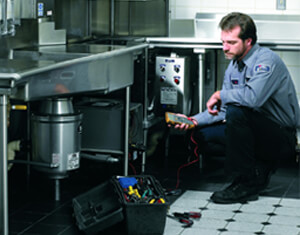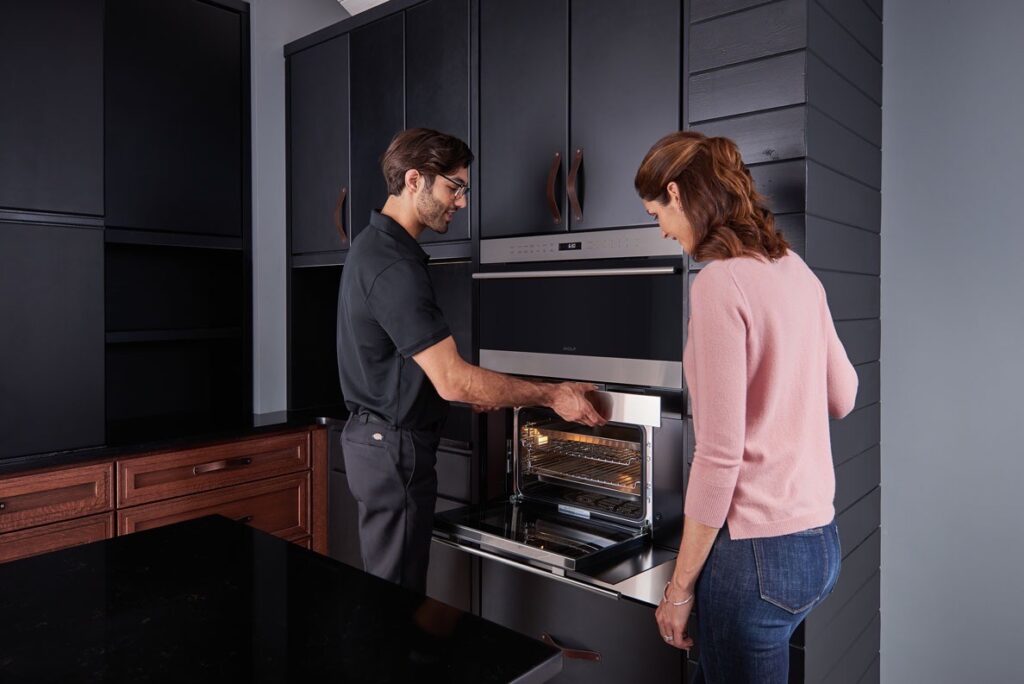Save Big by Acting on Repairs Early with Dependable Refrigeration & Appliance Repair Service Sub-Zero Appliance Repair
Save Big by Acting on Repairs Early with Dependable Refrigeration & Appliance Repair Service Sub-Zero Appliance Repair
Blog Article
The Ultimate Overview to DIY Device Repair Service Techniques
From fridges to dishwashing machines, recognizing how to fix and repair these devices can save you time and money. Are you ready to find vital techniques that will equip you to manage repair work with confidence?
Comprehending Usual Device Issues
When you count on your home devices, it can be irritating when they suddenly quit working or act up. Understanding typical home appliance issues can aid you fix issues properly.
If your stove isn't home heating, defective aspects or thermostat concerns could be at fault. Dish washers frequently experience troubles with water drainage, so see to it the filter is tidy and the drain hose isn't kinked.
Likewise, listen for uncommon sounds; they often show mechanical problems. By recognizing these indicators, you can save time and potentially avoid pricey fixings. A little knowledge goes a lengthy way in keeping your home appliances, so stay notified to keep whatever running efficiently.
Important Tools for DIY Repairs
Prior to diving into DIY device repair services, it's essential to collect the right tools to ensure the procedure goes efficiently. Start with an excellent collection of screwdrivers, consisting of both flathead and Phillips, as they're essential for opening up most home appliances. You'll also want a pair of pliers for gripping and twisting cables or small components.
Don't forget a multimeter; it aids you examination electric components and identify problems successfully. An outlet set comes in handy for loosening or tightening up bolts, while an utility blade can be beneficial for opening up or cutting cables packaging.
Lastly, consider having a flashlight available to brighten dark areas inside your home appliances. With these important devices, you'll be fully equipped to take on numerous repair work, conserving both money and time. So, gather your equipment and get all set to roll up your sleeves!
Safety And Security First: Preventative Measures to Take
Prior to you begin any type of home appliance fixing, it's vital to prioritize safety and security. Make sure you wear individual safety devices, disconnect the source of power, and keep your work area organized. These simple preventative measures can assist stop accidents and ensure a smoother repair procedure.

Personal Protective Devices
Safety gear is an important part of any do it yourself home appliance repair job. You should always use safety goggles to safeguard your eyes from dirt and particles. A tough pair of gloves will certainly shield your hands from sharp sides and dangerous products. Take into consideration making use of a mask if you're taking care of chemicals or dirt, guaranteeing you take a breath securely while working. Steel-toed boots are additionally a wise choice, especially when raising hefty appliances. Do not neglect to use long sleeves and pants to shield your skin from prospective injuries. By prioritizing personal safety tools, you'll considerably minimize the risk of injuries and crashes. Bear in mind, being prepared with the ideal equipment maintains you safe and concentrated on completing your repair work efficiently.
Power Source Disconnection
To assure a safe DIY appliance repair service, separating the power resource is important. This straightforward step avoids electric shocks and assurances that you can concentrate on the repair service without stressing concerning unexpected activation. When you're confident that the power is detached, you can confidently proceed with your repair work, understanding you've taken the required safety measures to shield yourself.
Workplace Organization
An efficient work location can make all the difference in your Do it yourself appliance fixing project. Beginning by clearing your work space of clutter to protect against diversions and accidents. A neat room not only improves efficiency yet also maintains you risk-free while you function on your home appliance fixing.
Step-by-Step Guide for Refrigerator Repair Works
When your fridge begins acting up, it can be discouraging, yet tackling the issue on your own can conserve you time and money. First, disconnect the refrigerator to assure safety. Look for typical concerns like temperature level fluctuations or unusual sounds. If it's not cooling, check the thermostat setups; they could be established too expensive. Next, clean the condenser coils, which typically gather dirt and particles. For a noisy refrigerator, check the follower and confirm it's not obstructed.
If there's water merging within, evaluate the door seals for damages or dirt, and clean them if required. When you've attended to the issue, plug the refrigerator back in and monitor it for a couple of hours.
Taking Care Of Cleaning Device Concerns
Similar to fridges, washing devices can present their own collection of difficulties, however several concerns can be fixed with a little troubleshooting. If your maker will not start, check the power cord and confirm it's connected in. Next off, check the door latch; a malfunctioning latch can stop the cycle from beginning. If you see uncommon noises throughout operation, it may be because of foreign items embeded the drum or the drain pump.
If your clothes aren't obtaining tidy, consider the water degree and cleaning agent type; utilizing as well much cleaning agent can create excess suds, affecting performance. For leaks, analyze the hose pipes for cracks or loose links. Tightening up these can usually address the problem. Normal upkeep, like cleaning the filter, can avoid several problems from emerging. Keep in mind, a little troubleshooting goes a lengthy way in keeping your cleaning maker running efficiently.
Troubleshooting Cooktops and stoves
Exactly how can you troubleshoot typical problems with your stove or oven? Start by checking the power supply.
If your oven isn't home heating, inspect the temperature setups and confirm the door seals firmly. A damaged burner might likewise be the wrongdoer; you might require to change it if it's damaged.
For unequal cooking, rotate your frying pans and take into consideration using an oven thermostat to validate precise temperatures. If you listen to unusual noises or odor gas, transform off the home appliance right away and seek advice from an expert. By adhering to these actions, you can identify and resolve lots of typical stove and oven concerns successfully.
Repairing Dish Washers Facilitated
When your dish washer begins breaking down, it can be discouraging, yet resolving common concerns isn't as hard as it appears. You'll find out detailed troubleshooting techniques that will assist you pinpoint the problem, together with the vital tools you'll require to take on repair work yourself. you can try this out Allow's make repairing your dishwashing machine a wind!
Typical Dishwashing Machine Issues
While dishwashers are made to make your life much easier, they can in some cases encounter common concerns that leave you feeling annoyed. One constant issue is bad cleaning performance; this often happens as a result of clogged spray arms or unclean filters. You may likewise navigate to these guys see water merging at the bottom, which can indicate a malfunctioning drainpipe or a kinked pipe. If your dishwashing machine's door will not latch, it can be a straightforward concern with the latch device or door seal. Furthermore, weird noises can signal damaged parts or loosened parts. If you smell something strange, it may be time to examine for food particles or a malfunctioning electric motor. Resolving these issues early can save you time and problem later on (Dependable Refrigeration & Appliance Repair Service SubZero Repair).

Step-by-Step Troubleshooting
Prior to diving right into repair services, it's vital to recognize the certain problem your dish washer is encountering. If it's not cleansing properly, Beginning by examining. Check the spray arms for blockages and guarantee they spin easily. Analyze door seals and hoses for any type of damages if it's dripping. For odd sounds, pay attention closely during cycles; international objects may be embeded the filter or impeller. If your dishwashing machine will not start, check the power supply and door latch. Don't fail to remember to consult your user manual for repairing suggestions specific to your version. By carefully addressing each possible issue, you can pinpoint the problem and take the essential actions to repair it, making your dishwasher function fresh once more.
Necessary Repair Devices
Having the right devices available can make all the distinction when fixing your dishwasher. Beginning with a screwdriver collection, as you'll often require both Phillips and flathead alternatives. A multimeter's important for identifying electrical concerns, while pliers can assist you grip and control various components. Don't forget a pail or towels for any water spills throughout repair work.
You could likewise want a degree to ensure your dishwasher's effectively aligned. With these necessary tools, you'll be well-appointed to take on any kind of dishwashing machine repair work challenge that comes your method.
Frequently Asked Concerns
How Do I Figure out if a Device Is Well Worth Fixing?
To identify if a home appliance's worth repairing, consider its age, fixing costs, and current value. If fixings go beyond half the replacement cost, you might wish to buy a new model rather.
Can I Find Substitute Parts Locally for My Appliance?
Yes, you can usually find substitute components in your area for your device. Check equipment shops, device service center, or regional classifieds. Don't forget to bring the model number to assure you get the right part!
When Fixing Home Appliances?, what Common Mistakes Should I Stay Clear Of.
When fixing devices, stay clear of rushing with diagnostics, neglecting safety and security preventative measures, or using wrong devices. Don't skip checking out handbooks or watching tutorials; they important site provide vital advice. Hold your horses and complete to assure effective repairs and protect against more damages.
For how long Does a Regular Do It Yourself Device Repair Work Take?
A normal DIY device repair normally takes one to three hours, depending upon the intricacy. You'll wish to collect your tools and materials first, and follow directions meticulously to prevent unneeded hold-ups.
Are There Any Kind Of Service Warranties for DIY Home Appliance Services?
When you take on DIY device repair work, guarantees commonly do not cover your work. However, some producers might honor warranties for components you replace. Always check your appliance's guarantee terms before beginning any type of fixings to stay clear of problems.
Before diving right into Do it yourself device repairs, it's essential to collect the right tools to guarantee the procedure goes efficiently.Before you begin any device repair service, it's essential to focus on security.To assure a risk-free DIY appliance fixing, detaching the power source is vital.An efficient job area can make all the distinction in your DIY appliance repair service task. Always examine your appliance's warranty terms prior to starting any kind of repair work to avoid concerns.
Report this page